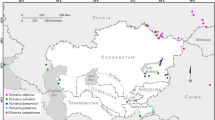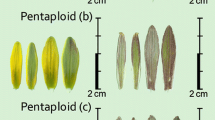Abstract
Nuclear DNA content was estimated using flow cytometry in 13 sections represented by 18 species of the genusTaraxacum using propidium iodide as the DNA stain. Investigated plants represented diploid, triploid and tetraploid species from sections considered both primitive and advanced, i.e.,T. sect.Dioszegia, Piesis, Glacialia, Mongolica, Scariosa, Obovata, T. pyrenaicum group,T. sect.Coronata, Palustria, Taraxacum (=Crocea),Kashmirana, Ruderalia andErythrosperma. Estimated nuclear 2C DNA content ranged from 1.74 pg in diploidT. linearisquameum (T. sect.Ruderalia) to 6.91 pg in tetraploidT. albidum (T. sect.Mongolica), demonstrating 3.97-fold variation. The lowest monoploid genome size 1Cx=0.87 pg was recorded inT. linearisquameum (T. sect.Ruderalia) together withT. brachyglossum (T. sect.Erythrosperma), and the highest one (1.73 pg) was recorded inT. albidum (T. sect.Mongolica), giving a 1.99-fold difference in the genus. No significant differences in genome size were observed withinT. sect.Ruderalia, similarly no intraspecific variation was observed inT. paludosum (T. sect.Palustria) andT. serotinum (T. sect.Dioszegia). These results indicate a high intraspecific stability of the trait. Preliminary comparisons of genome size in species/sections considered to be close relatives were made. These data give tentative additional evidence for the close phylogenetic relationship between sectionsPalustria andPiesis and against the close relationship between sectionsPiesis andDioszegia.
Similar content being viewed by others
References
Barlow P. (1981): Pers. comm. Http://www.rbgkew.org.uk/cval/homepage.html (2004).
Bennett M.D., Bhandol P. &Leitch I.J. (2000a): Nuclear DNA amounts in angiosperms and their modern uses — 807 new estimates.Ann. Bot. (Oxford) 86: 859–909.
Bennett M.D., Johnston S., Hodnet G.L. &Price H.J. (2000b):Allium cepa L. cultivars from four continents compared by flow cytometry show nuclear DNA constancy.Ann. Bot. (Oxford) 85: 351–357.
Bennett M.D., Leitch I.J. &Hanson L. (1998): DNA amounts in two samples of angiosperms weeds.Ann. Bot. 82 (Suppl. A): 121–134.
Bennett M.D., Smith J.B. &Lewis Smith R.I. (1982): DNA amounts of angiosperms from the Antarctic and South Georgia.Environm. Exp. Bot. 22: 307–318.
Bennetzen J.L. (2002): Mechanisms and rates of genome expansion and contraction in flowering plants.Genetica 115: 29–36.
Doležel J., Bartoš J., Voglmary H. &Greilhuber J. (2003): Nuclear DNA content and genome size of trout and human.Cytometry Part A 51A: 127–128.
Doležel J. &Göhde W. (1995): Sex determination in dioecious plantsMelandrium album andM. rubrum using high-resolution flow cytometry.Cytometry 19: 103–106.
Doll R. (1973): Revision der sect.ErythrospermaDahlst. emend.Lindb. f. der GattungTaraxacumZinn. (Teil I.).Feddes Repert. 83: 673–740.
Doll R. (1976): Die SectionScariosa H.-M. emend.Dahlst. der GattungTaraxacum.Feddes Repert. 87: 553–585.
Doll R. (1982): Grundriss der Evolution der GattungTaraxacumZinn.Feddes Repert. 93: 481–624.
Ellul P., Boscaiu M., Vicente O., Moreno V. &Rosselló J.A. (2002): Intra- and interspecific variation in DNA content inCistus (Cistaceae).Ann. Bot. (Oxford) 90: 345–351.
Handel-Mazzetti H. von (1907):Monographie der Gattung Taraxacum. Leipzig & Wien.
Hanson L., McMahon K.A., Johnson M.A.T. &Bennett M.D. (2001): First nuclear DNA C-values for 25 angiosperm families.Ann. Bot. (Oxford) 87: 251–258.
Hughes J. &Richards A.J. (1989): Isozymes and the status ofTaraxacum (Asteraceae) agamospecies.Bot. J. Linn. Soc. 99: 365–376.
Jakob S.S., Meister A. &Blattner F.R. (2004): Considerable genome size variation ofHordeum species (Poaceae) is linked to phylogeny, life form, ecology, and speciation rates.Molec. Biol. Evol. 21: 860–869.
Kirschner J. &Štěpánek J. (1996): Modes of speciation and evolution of the sections inTaraxacum.Folia Geobot. Phytotax. 31: 415–426.
Kirschner J. &Štěpánek J. (1997): A nomenclatural checklist of supraspecific names inTaraxacum.Taxon 46: 87–98.
Kirschner J. &Štěpánek J. (1998a):A monograph of Taraxacumsect. Palustria. Institute of Botany, Průhonice.
Kirschner J. &Štěpánek J. (1998b): A Revision ofTaraxacum sect.Piesis (Compositae).Folia Geobot. 33: 391–414.
Kirschner J., Štěpánek J., Tichý M., Krahulcová A., Kirschnerová L. &Pellar L. (1994): Variation inTaraxacum bessarabicum and allied taxa of the sectionPiesis (Compositae): Allozyme diversity, karyotypes and breeding behaviour.Folia Geobot. Phytotax. 29: 61–83.
Kirschner J., Štěpánek J., Mes T.H.M., Den Nijs J.C.M., Oosterveld P, Štorchová H. &Kuperus P. (2003): Principal features of the cpDNA evolution inTaraxacum (Asteraceae, Lactuceae): a conflict with taxonomy.Pl. Syst. Evol. 239: 231–255.
Lysák M.A. &Doležel J. (1998): Estimation of nuclear DNA content inSesleria (Poaceae).Caryologia 51: 123–132.
Małecka J. (1967): Processes of intraspecific differentiation in the genusTaraxacum.Genet. Polon. 8: 185–188.
Moscone E.A., Baranyi M., Ebert I., Greilhuber J., Ehrendorfer F. &Hunziker A.T. (2003): Analysis of nuclear DNA content inCapsicum (Solanaceae) by flow cytometry and feulgen densitometry.Ann. Bot. (Oxford) 92: 21–29.
Naganowska B., Wolko B., Šliwińska E. &Kaczmarek Z. (2003): Nuclear DNA content variation and species relationships in the genusLupinus (Fabaceae).Ann. Bot. (Oxford) 92: 349–355.
Petrov D.A. (2001): Evolution of genome size: new approaches to an old problem.Trends Genet. 17: 23–28.
Richards A.J. (1973): The origin ofTaraxacum agamospecies.Bot. J. Linn. Soc. 66: 189–211.
SanMiguel P. &Bennetzen J.L. (1998): Evidence that a recent increase in maize genome size was caused by the massive amplification of intergene retrotransposons.Ann. Bot. (Oxford) 82: 37–44.
SanMiguel P., Gault B.S., Tikhonov A., Nakajima Y. &Bennetzen J.L. (1998): The paleontology of intergene retrotranspozons of maize.Nat. Gen. 20: 43–45.
SanMiguel P., Tikhonov A., Jin Y.K., Motchoulskaia N., Zakharov D., MelakeBerhan A., Springer P.S., Edwards K.J., Lee M., Avramova Z. &Bennetzen J.L. (1996): Nested retrotransposons in the intergenic regions of the maize genome.Science 274: 765–768.
Soltis D.E., Soltis P.S., Bennett M.D. &Leitch I.J. (2003): Evolution of genome size in the angiosperms.Amer. J. Bot. 90: 1596–1603.
Suda J., Kyncl T. &Freiová R. (2003): Nuclear DNA amounts in Macaronesian angiosperms.Ann. Bot. (Oxford) 92: 153–164.
Swift H. (1950): The constancy of deoxyribose nucleic acid in plant nuclei.Proc. Natl. Acad. Sci. USA 36: 643–654.
Van Soest J.L. (1954): Sur quelques Taraxaca d’Espagne.Collect. Bot. (Barcelona) 4(1/1): 1–32.
Van Soest J.L. (1958): Thy phytogeography ofTaraxacum with special reference to Europe.Blumea 4 (suppl.): 60–67.
Van Soest J.L. (1963):Taraxacum species from India, Pakistan and neighbouring countries.Wentia 10: 1–91.
Wendel J.F., Cronn R.C., Johnston J.S. &Price H.J. (2002): Feast and famine in plant genomes.Genetica 115: 37–47.
Wicker T., Stein N., Albar L., Feuillet C., Schlagenhauf E. &Keller B. (2001): Analysis of a contiguous 211 kb sequence in diploid wheat (Triticum monococcum L.) reveals multiple mechanisms of genome evolution.Pl. J. 26: 307–316.
Wittzell H. (1999): Chloroplast DNA variation and reticulate evolution in sexual and apomictic sections of dandelions.Molec. Ecol. 8: 2023–2035.
Author information
Authors and Affiliations
Corresponding author
Rights and permissions
About this article
Cite this article
Záveský, L., Jarolímová, V. & Štěpánek, J. Nuclear DNA content variation within the genusTaraxacum (Asteraceae). Folia Geobot 40, 91–104 (2005). https://doi.org/10.1007/BF02803047
Received:
Revised:
Accepted:
Issue Date:
DOI: https://doi.org/10.1007/BF02803047




